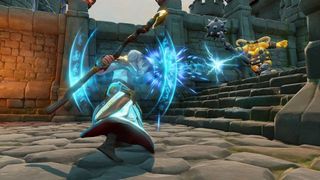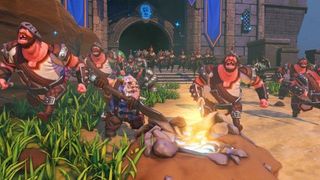Orcs Must Die! Unchained hands-on: don't let the fact that it's a lane pusher scare you

Robot Entertainment didn't set out to make a MOBA, but design director Ian Fischer told me that's what everyone thinks Orcs Must Die! Unchained is, and he's not going to fight it.
It makes sense when you see how the game is set up. Imagine the original Orcs Must Die! games, where you defend your fortress from waves of orcs by setting up traps, or wading into the battle yourself. Mirror that setup and you'll get Unchained's basic premise: Two fortresses with two teams protecting them, and two armies of orcs heading in opposite directions. Consider that the orcs move through multiple lanes between the fortresses, a roster of heroes that lend themselves to different roles (ranged dps, melee tank), and the MOBA label makes sense.
You start the match by setting up traps—burning coals, spikes, swinging maces, etc, and picking your special abilities, as you did in the previous games. The exciting new addition is that you also get to choose what kind of wave of mobs (or creeps, if you will) your enemy will face. You can opt for your plain vanilla orcs, very fast but easy to kill rats, or hulking ogre damage sponges. Each player can pick one unit for each gate, but you can also upgrade and open more gates to unleash more, stronger units.

The opposing team is doing the same, of course, and soon heroes and their hordes meet somewhere in the middle in chaos. Ogres fight bears, wolfmen claw at orcs, and heroes fire magic missiles that explode in the middle of the crowd. The game still has the tone of Saturday Morning Cartoon, but Robot has upgraded from the Trinigy engine to Unreal Engine 3, so character models for both enemies and heroes are more detailed, colors look more vibrant, and the action is a joyous mess of explosions and ragdolls.
It seems like random madness, but there's a staggering amount of strategy behind it all. Different heroes pick which unique abilities, units, traps, buffs, and other passive bonuses before the match starts. Each of these is represented by a card, which make up your “deck.” With five players and an endless combination of decks, there's no end to the strategies you can come up with if you work together.
As Bloodspike, an orcish hero that's good at close range, I customized my deck to spawn ogres that can take a lot of damage and a buff that makes them even stronger. Ogres are a higher tier unit, meaning I had to upgrade my team's gate a few times before I could release them. I couldn't do much on offense without their support, so I spent the early part of the match setting up defenses and earning as much currency as I could to upgrade our gate by picking on easy targets.

Depending on your deck and team, sometimes you want to take the lead and clear the way for your orcs, sometimes you want to hang back and let them take most the damage, and sometimes you want to be right in the middle of the action, but it's always absolutely critical for everyone to move together in large groups. An attack of just heroes or just orcs is doomed to fail.
PC Gamer Newsletter
Sign up to get the best content of the week, and great gaming deals, as picked by the editors.
This forces a nice ebb and flow on every match, where you're naturally shifting between attack and defense phases. I was constantly doing different things, not just in terms of strategy, but moment to moment, jumping at the opportunity to take down a weak enemy player, or running back to my fortress to frantically adjust traps based on the last wave the enemy threw at us.
When they were ready, I joined my ogres and the rest of my team's march on the enemy rift. By hobbling enemy heroes with a special attack and using another special ability that disables traps for a short time, I was able to reach the opposing team's rift with a fair amount of health. With a few of my fellow heroes at my back and my buffed up ogres, we were able to break through the final gate, step into the rift, and win the match.

I'll admit that it was in part luck and part Fischer giving me advice while I played, but I could already see how a little bit of coordination was a huge advantage, how the other team could counter my ogres (we were pretty helpless against ranged attacks), and how I could counter that counter.
If you've played any League of Legends or Dota 2 , this is probably starting to sound very familiar. The difference is that good strategy alone was not enough. I still needed fair aim and shooter-like reaction times, which kept me engaged where other MOBAs didn't.
Orcs Must Die! Unchained will also be free-to-play, but I don't suspect Robot will monetize too aggressively. The plan is to start each player off with five heroes and sell additional heroes, cosmetic upgrades, and shortcuts to more cards for your deck. Since all critical gameplay content can be unlocked through play, it sounds fair, and given how great the game looks, I might even be tempted to buy a cosmetic upgrade or two to customize my orcs.

However, it makes me worry about the old, single-player mode, which Fischer said it plans to add in the future, after Orcs Must Die! Unchained launches. The multiplayer mode is worth playing as is, but I'd be pretty disappointed if Robot didn't give as much attention to more single-player Orcs Must Die! experiences that take advantage of the new engine, heroes, and abilities.
Lane pushers seem like a dime a dozen at this point, but I do think that Orcs Must Die! Unchained's distinguishing features—emphasis on building defenses and fine tuning your team's creeps/mobs—is promising. It's not just a “me too” product with a couple of novel twists. It feels more like a unique game that evolved into a unique multiplayer mode that just so happens to be very similar to a MOBA.
Most Popular

